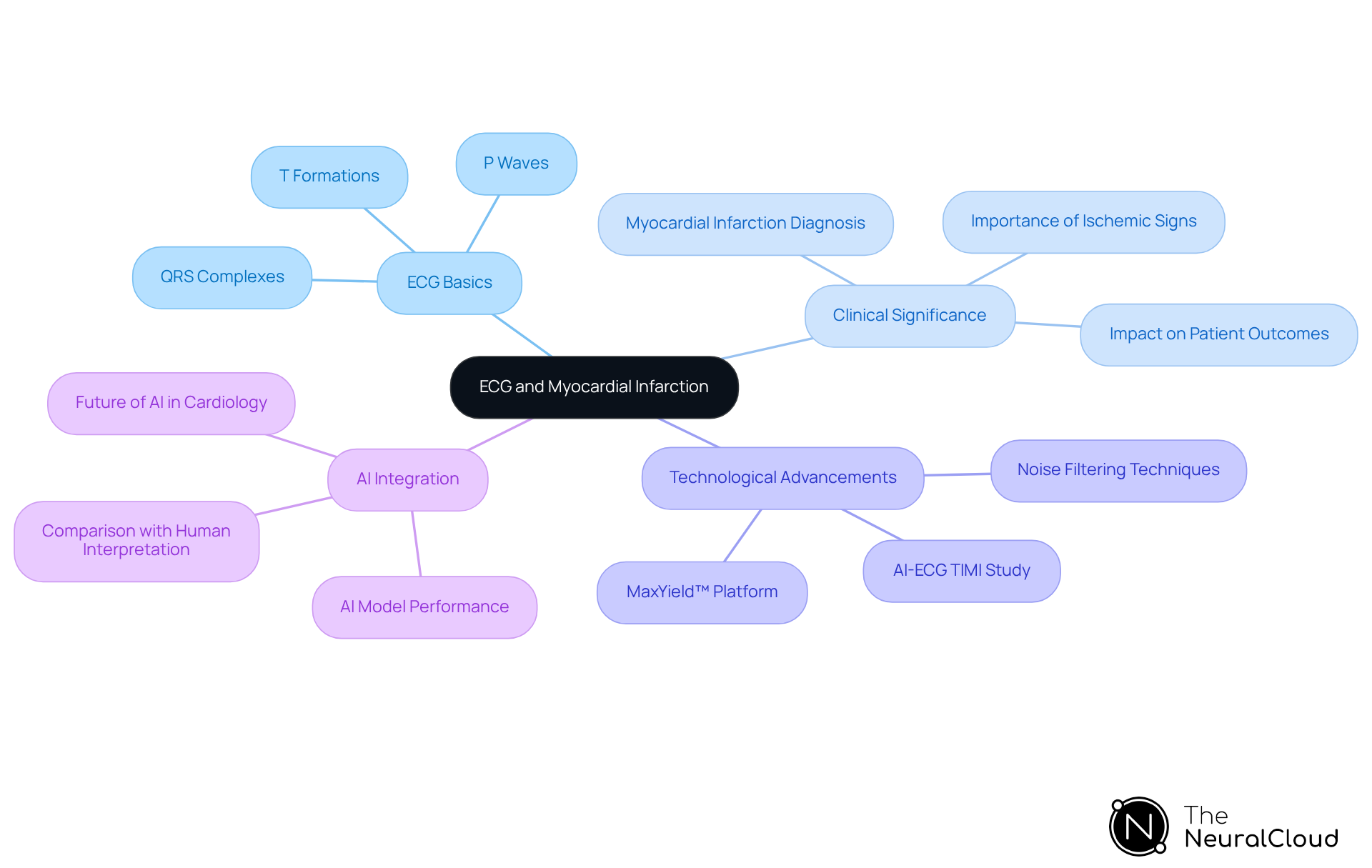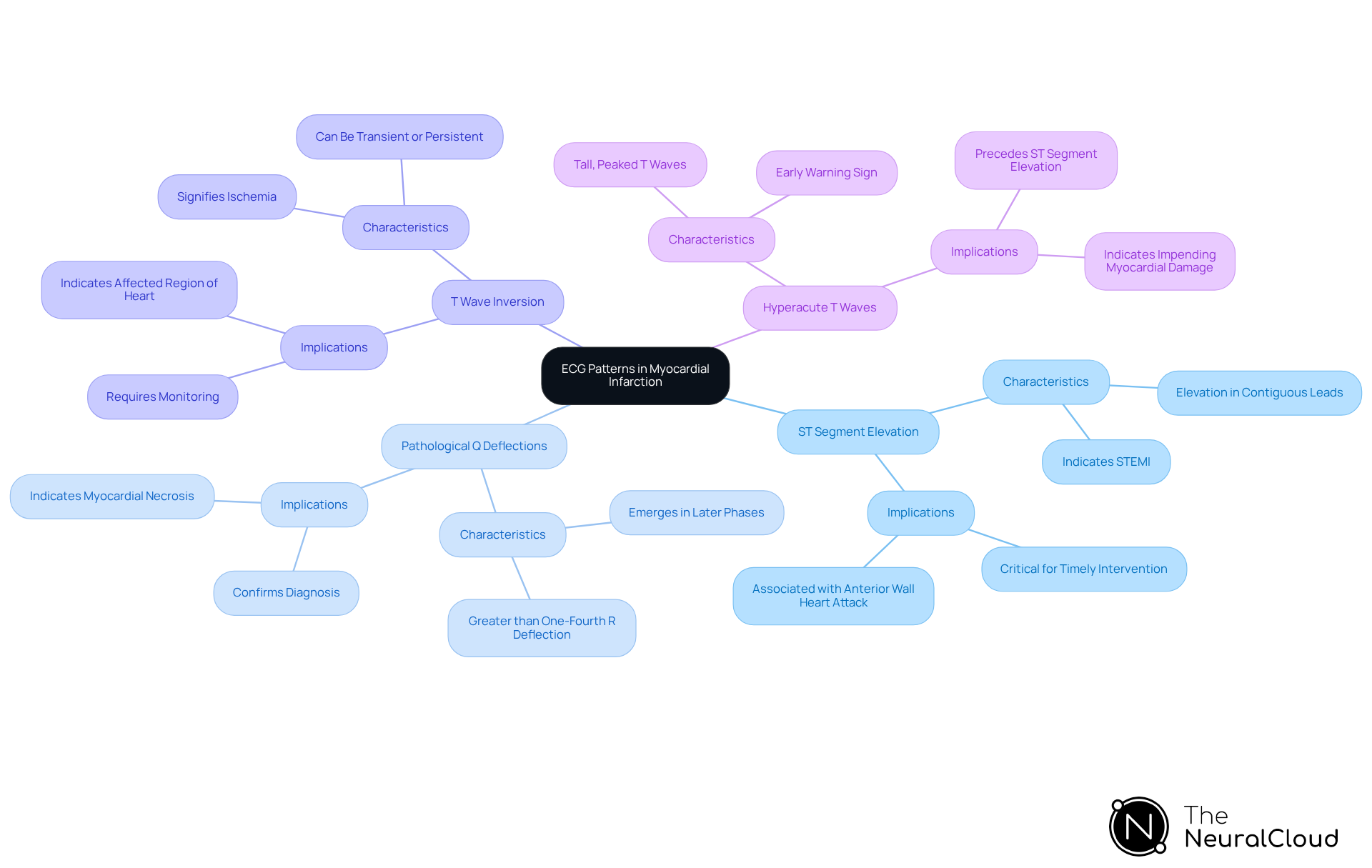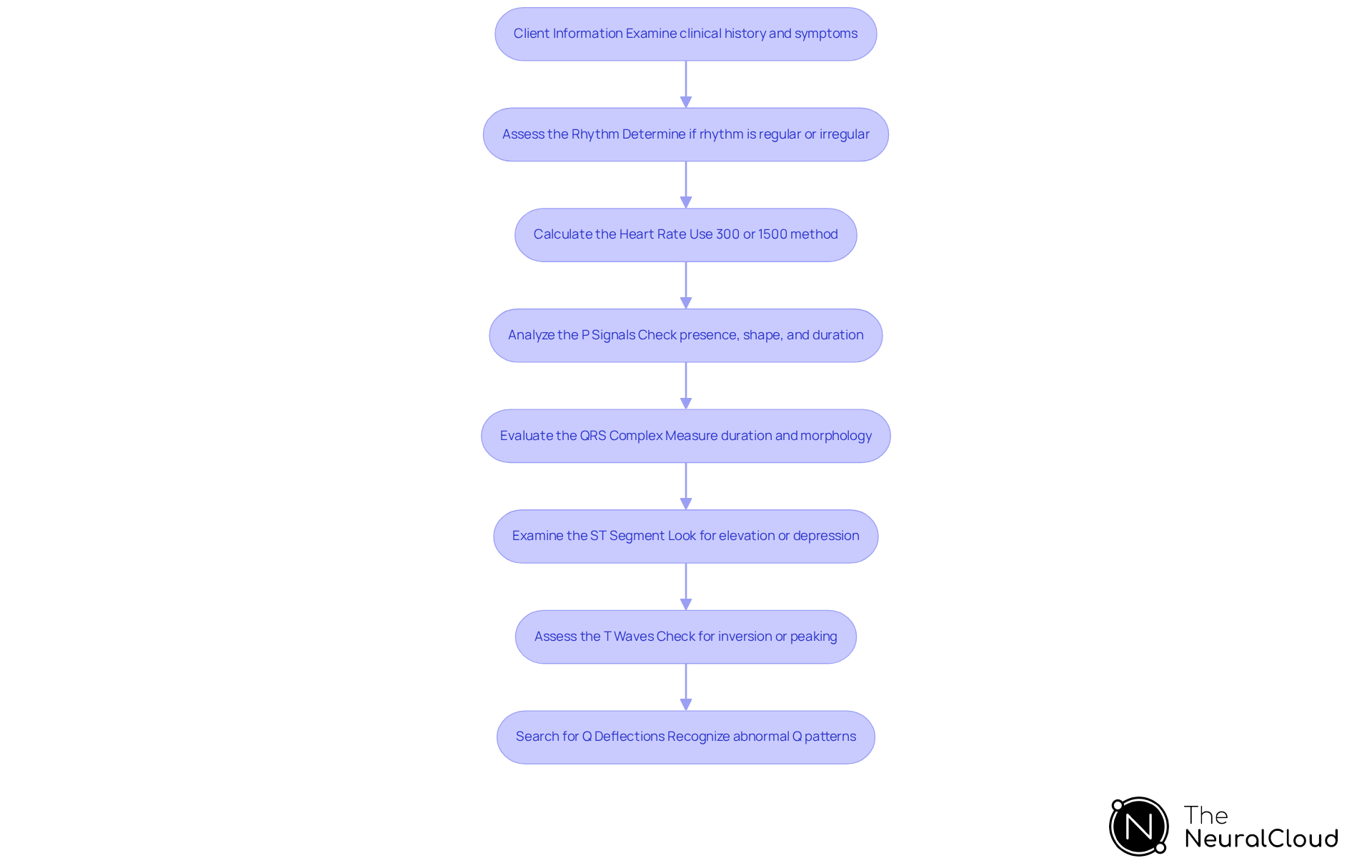Overview
The article centers on mastering the interpretation of myocardial infarction (MI) ECGs through a systematic approach. It highlights the challenges faced in ECG analysis and underscores the importance of understanding key ECG patterns, such as ST segment elevation and pathological Q deflections. The article outlines a step-by-step process for accurate analysis, enhanced by advanced tools like the MaxYield™ platform.
The MaxYield™ platform provides features that significantly improve ECG analysis. It offers advanced diagnostic tools that streamline the interpretation process, allowing healthcare professionals to identify critical patterns more efficiently. By utilizing this platform, practitioners can enhance their diagnostic accuracy, leading to better patient outcomes.
The advantages of using the MaxYield™ platform are clear. Healthcare professionals benefit from improved efficiency in ECG analysis, which translates to quicker decision-making and enhanced patient care. The platform not only simplifies complex information but also supports practitioners in making informed clinical decisions.
In conclusion, mastering MI ECG interpretation requires a comprehensive understanding of key patterns and the utilization of advanced tools like MaxYield™. By integrating these elements, healthcare professionals can significantly enhance their diagnostic capabilities and ultimately improve patient care.
Introduction
Understanding the intricacies of electrocardiograms (ECGs) is essential for healthcare professionals tasked with diagnosing myocardial infarctions, commonly known as heart attacks. This guide delves into the fundamental elements of ECG interpretation, offering a step-by-step approach that empowers clinicians to accurately identify critical cardiac events and improve patient outcomes.
Despite advancements in technology and training, many still grapple with the complexities of ECG analysis. Common pitfalls in ECG interpretation can hinder timely and accurate diagnoses, making it crucial for professionals to effectively navigate these challenges.
Understand the Basics of ECG and Myocardial Infarction
Electrocardiograms (ECGs) are vital graphical representations of the heart's electrical activity, crucial for diagnosing various cardiac conditions, particularly myocardial infarction ECG, which is commonly known as a heart attack. An MI occurs when blood flow to a section of the heart is obstructed, leading to tissue damage. Understanding the —P waves, QRS complexes, and T formations—is essential for precise interpretation, as each element corresponds to specific phases of the heart's electrical cycle. Deviations from the norm can indicate significant underlying issues.
For instance, ST segment elevation is a classic indicator of ST-Elevation Myocardial Infarction (STEMI), while ST segment depression may suggest Non-ST-Elevation Myocardial Infarction (NSTEMI). Research indicates that a substantial percentage of healthcare professionals rely on ECGs for cardiac diagnosis, underscoring their importance in clinical practice. Familiarity with these basic elements enhances the ability to interpret ECGs effectively and identify critical cardiac events swiftly.
Leading cardiologists emphasize the significance of these ECG components in clinical decision-making. Grasping the nuances of P waves, QRS complexes, and T phenomena can lead to timely interventions that significantly enhance patient outcomes. Real-world applications of myocardial infarction ECG have demonstrated its effectiveness in diagnosing heart attacks, with advanced AI models achieving accuracy rates exceeding 90% in identifying occluded coronary arteries. This underscores the transformative potential of integrating technology with traditional ECG interpretation, ultimately enhancing cardiac care.
The MaxYield™ platform from Neural Cloud Solutions addresses the challenges in ECG analysis by utilizing advanced noise filtering and unique signal recognition. This platform enables the rapid isolation of ECG waves even in recordings with significant noise and artifacts, effectively tackling issues such as physiological variability and signal artifacts. The MaxYield™ platform not only enhances the overall efficiency and accuracy of cardiac care but also equips healthcare professionals with the necessary tools to navigate complex ECG data effectively.
Furthermore, the AI-ECG TIMI Study aims to validate the use of AI for detecting and managing acute coronary syndromes, reinforcing the relevance of these advancements in contemporary clinical practice. Persistent ischemic signs in ECGs can indicate a higher risk of adverse cardiac events, emphasizing the need for healthcare professionals to be adept at interpreting these signals.

Identify Key ECG Patterns Associated with Myocardial Infarction
Multiple significant ECG patterns, including myocardial infarction ECG, indicate heart attacks, each providing vital insights into the severity and location of the condition. The most notable patterns include:
- [ST Segment Elevation](https://theneuralcloud.com/post/10-key-stemi-mimics-every-health-tech-developer-should-know): This hallmark finding in ST-Elevation Myocardial Infarction (STEMI) is characterized by an elevation of the ST segment in two or more contiguous leads. For example, ST elevation greater than 1 mm in leads V2 and V3 signals an anterior wall heart attack, which is critical for timely intervention.
- Pathological Q Deflections: The emergence of pathological Q deflections, defined as greater than one-fourth the height of the R deflection, in leads corresponding to the infarcted area indicates myocardial necrosis. This finding typically emerges in the later phases of a heart attack and is crucial for confirming the diagnosis.
- T Wave Inversion: Inversions of the T wave can signify ischemia and may manifest in the leads that face the affected region of the heart. These inversions can be transient or persistent, depending on the duration and severity of ischemia.
- Hyperacute T Waves: These tall, peaked T waves may appear early in the course of a myocardial infarction, often preceding ST segment elevation. Their presence can serve as an early warning sign of impending myocardial damage.
Understanding these myocardial infarction ECG patterns is essential for healthcare professionals, as precise interpretation of myocardial infarction ECG can significantly and improve outcomes for patients. Recent studies highlight the importance of identifying ST segment elevation, with data indicating that approximately 38% of individuals presenting with acute coronary syndrome have a STEMI. Furthermore, the appearance of new pathological Q waves serves as a critical indicator of myocardial infarction, reinforcing the need for prompt recognition and intervention to mitigate complications.

Follow a Step-by-Step Process for ECG Interpretation
To interpret an ECG effectively, follow these steps:
- Client Information: Begin by examining the individual's clinical history and symptoms. This context is crucial for accurate interpretation, as it helps identify potential underlying conditions that may affect the ECG. MaxYield™ enables clinicians to swiftly access and analyze relevant patient data, enhancing their understanding of the ECG results.
- Assess the Rhythm: Determine whether the rhythm is regular or irregular. Look for P signals and their connection to QRS complexes to evaluate atrial activity, which is essential for diagnosing arrhythmias. MaxYield™ assists in this step by filtering out noise, allowing for clearer visualization of waveforms.
- Calculate the Heart Rate: Utilize the 300 method (counting large squares between R peaks) or the 1500 method (counting small squares) to determine the heart rate. Accurate heart rate calculation is vital for assessing the patient's cardiac status. The MaxYield™ platform can automate this calculation, reducing the potential for human error.
- Analyze the P Signals: Check for the presence, shape, and duration of P signals. This assessment helps evaluate atrial function and can indicate conditions such as atrial enlargement or atrial fibrillation. MaxYield™ enhances this analysis by providing distinct wave recognition, even in noisy recordings.
- Evaluate the QRS Complex: Measure the duration and morphology of the QRS complex. A wide QRS may indicate a conduction delay, which can be critical in diagnosing various cardiac conditions. The platform's advanced algorithms can highlight abnormalities in real-time.
- Examine the ST Segment: Look for elevation or depression. ST segment elevation exceeding 1 mm in adjacent leads suggests STEMI, a crucial observation in the myocardial infarction ECG related to acute myocardial damage. MaxYield™ can assist in identifying these changes promptly.
- Assess the T Waves: Check for inversion or peaking, which can indicate ischemia or tissue death. Alterations in T shape morphology can provide insights into the patient's cardiac health. The of MaxYield™ ensure that these subtle changes are not overlooked.
- Search for Q Deflections: Recognize any abnormal Q deflections that may suggest prior myocardial infarction. The existence of Q patterns can indicate significant cardiac occurrences that necessitate further examination. MaxYield™ can effectively differentiate between normal and pathological Q patterns.
In clinical settings, the average time taken for healthcare professionals to interpret ECGs can vary significantly. However, with the integration of advanced platforms like MaxYield™, which utilizes sophisticated noise filtering and distinct wave recognition, the efficiency and accuracy of ECG analysis can be greatly enhanced. Studies indicate that innovative teaching methods can reduce reading time from 32 minutes to just 18 minutes while improving accuracy from 43% to 77%. This underscores the importance of effective training and the role of automated solutions in enhancing ECG interpretation skills.
Healthcare professionals emphasize that understanding an individual's history is vital in ECG analysis, as it provides essential context that can influence interpretation and subsequent clinical decisions. By following these systematic steps and leveraging the capabilities of MaxYield™, clinicians can effectively analyze an ECG and identify potential abnormalities related to heart attacks.

Troubleshoot Common ECG Interpretation Errors
Common errors in ECG interpretation include:
- Lead Misplacement: Incorrect placement of electrodes is a prevalent issue, with studies indicating that misplacement can lead to significant misdiagnoses. For instance, electrode misplacement can result in false readings, causing clinicians to misinterpret normal heart rhythms as pathological. It is essential to double-check lead placement before interpreting the ECG to avoid these pitfalls.
- Ignoring Clinical Context: Failing to consider the individual's symptoms and medical history can lead to misinterpretation. ECG findings must always be correlated with clinical data to ensure accurate diagnosis. Numerous individuals showing ST elevation on their ECG may not be experiencing a myocardial infarction, highlighting the significance of context.
- Overlooking Artifacts: Artifacts can mimic pathological changes, complicating interpretation. Common artifacts, such as muscle tremors or electrical interference, must be distinguished from true ECG changes. Awareness of these artifacts is crucial for accurate readings.
- Misinterpreting Normal Variants: Some ECG findings may represent normal variants, particularly in athletes. Familiarizing oneself with these variants can prevent unnecessary alarm and misdiagnosis.
- Relying Solely on Automated Interpretations: While automated systems can assist in ECG analysis, they are not infallible. Research indicates that can be inaccurate up to 20% of the time, resulting in critical mistakes in treatment. Therefore, it is vital to manually review the ECG to confirm findings.
By recognizing these common pitfalls and implementing strategies to mitigate them, healthcare professionals can significantly enhance their ECG interpretation skills, ultimately improving patient outcomes.

Conclusion
Understanding the intricacies of myocardial infarction ECG interpretation is crucial for healthcare professionals tasked with diagnosing and managing heart conditions. This guide provides a comprehensive approach to interpreting ECGs, emphasizing the importance of recognizing key patterns associated with myocardial infarction, such as:
- ST segment elevation
- Pathological Q deflections
- T wave inversions
By mastering these elements, clinicians can enhance their diagnostic accuracy and ultimately improve patient outcomes.
The article outlines a systematic step-by-step process for ECG interpretation, highlighting the need for:
- Thorough patient history assessment
- Rhythm analysis
- Heart rate calculation
- Careful evaluation of each ECG component
Additionally, it addresses common pitfalls in ECG interpretation, such as lead misplacement and the importance of contextualizing findings with clinical data. Leveraging advanced tools like the MaxYield™ platform further aids in reducing errors and enhancing the efficiency of ECG analysis.
The MaxYield™ platform features advanced algorithms that streamline ECG analysis, allowing for quicker identification of critical patterns. This improvement not only enhances diagnostic accuracy but also reduces the cognitive load on healthcare professionals, enabling them to focus on patient care. By integrating the MaxYield™ platform into clinical practice, healthcare providers can significantly reduce the risk of misinterpretation and improve overall patient outcomes.
In conclusion, the ability to accurately interpret ECGs is a vital skill in the clinical setting, particularly in the context of myocardial infarction. As advancements in technology continue to evolve, integrating these tools into practice will be essential for refining diagnostic capabilities. By prioritizing education, training, and the use of innovative platforms, healthcare professionals can significantly elevate the standard of cardiac care and ensure timely interventions for patients experiencing heart attacks.
Frequently Asked Questions
What is an electrocardiogram (ECG)?
An electrocardiogram (ECG) is a vital graphical representation of the heart's electrical activity, crucial for diagnosing various cardiac conditions, particularly myocardial infarction (MI), commonly known as a heart attack.
What is a myocardial infarction (MI)?
A myocardial infarction (MI) occurs when blood flow to a section of the heart is obstructed, leading to tissue damage.
What are the fundamental elements of an ECG?
The fundamental elements of an ECG include P waves, QRS complexes, and T formations, each corresponding to specific phases of the heart's electrical cycle.
What do deviations in ECG readings indicate?
Deviations from the norm in ECG readings can indicate significant underlying cardiac issues.
What is ST-Elevation Myocardial Infarction (STEMI)?
ST-Elevation Myocardial Infarction (STEMI) is characterized by ST segment elevation on an ECG, indicating a severe heart attack.
What does ST segment depression indicate?
ST segment depression may suggest Non-ST-Elevation Myocardial Infarction (NSTEMI), which is a type of heart attack.
How important are ECGs in clinical practice?
A substantial percentage of healthcare professionals rely on ECGs for cardiac diagnosis, highlighting their importance in clinical practice.
How can understanding ECG components impact patient outcomes?
Grasping the nuances of ECG components can lead to timely interventions, significantly enhancing patient outcomes.
What advancements have been made in ECG interpretation technology?
Advanced AI models have achieved accuracy rates exceeding 90% in identifying occluded coronary arteries, showcasing the transformative potential of integrating technology with traditional ECG interpretation.
What is the MaxYield™ platform?
The MaxYield™ platform from Neural Cloud Solutions utilizes advanced noise filtering and unique signal recognition to enhance the efficiency and accuracy of ECG analysis, allowing for rapid isolation of ECG waves even in noisy recordings.
What is the AI-ECG TIMI Study?
The AI-ECG TIMI Study aims to validate the use of AI for detecting and managing acute coronary syndromes, reinforcing the relevance of these advancements in contemporary clinical practice.
Why is it important for healthcare professionals to interpret persistent ischemic signs in ECGs?
Persistent ischemic signs in ECGs can indicate a higher risk of adverse cardiac events, emphasizing the need for healthcare professionals to be adept at interpreting these signals.






